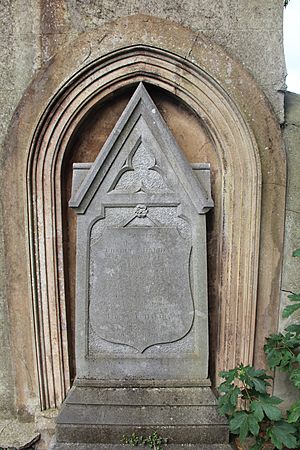Charles Haliday facts for kids
Charles Haliday (born 1789, died 1866) was an Irish person who cared a lot about public health. He also loved history and old things, especially about Dublin. He was very interested in the Viking history of the city.
Contents
Early Life
Charles Haliday was born in Carrick-on-Suir in County Tipperary in 1789. His father, William Halliday, was an apothecary, which is like a pharmacist. Charles was the second of four sons. For a few years, he worked in London as a clerk in a bank. Later, he became a commission agent.
After his older brother, William, passed away, Charles moved back to Dublin. He took over a family business that sold timber and bark on Arran Quay. Around 1825, he changed the spelling of his last name from Halliday to Haliday. He married Mary Hayes from Mountmellick.
Helping Dublin's Health
In 1832, a serious illness called cholera came to Dublin. Charles Haliday became a strong supporter for better living conditions for the city's poor people. He worked on this for the rest of his life. His main goals were to get proper drainage systems and clean drinking water for working-class families in Dublin.
He also helped protect public spaces. For example, when a railway was being built along the Dublin coast, Haliday made sure people could still get to a swimming area at Dun Laoghaire. When the new Connolly Station was being built, he spoke up to make sure the beautiful view of the Custom House from Westmoreland Street was not blocked by a new bridge.
In 1833, he was chosen to be a member of the Ballast Board. This group worked to improve Dublin harbour and manage lighthouses along the Irish coast. Charles Haliday also served as the consul for Greece for many years. He was an important secretary for the Chamber of Commerce in Dublin and a director of the Bank of Ireland.
Studying History and Collecting Books
In 1847, Charles Haliday became a member of the Royal Irish Academy (RIA). This is a group that promotes learning and research in Ireland. In 1850, he started researching the history of Dublin's port for the Ballast Board. This research led him to study the city's Viking history in great detail. This was a topic that most historians had not looked at much before.
In 1834, Haliday moved to Monkstown in County Dublin. In 1843, he bought a large property called Monkstown Park. He tore down the old house and built a new one. His new home had a very big library. This was perfect for his growing collection of books and papers about Irish history. Haliday loved collecting old things. He gathered one of the largest private collections of Irish historical works. When he died, his library had between 25,000 and 35,000 pamphlets about Ireland. He also had countless books, old stories, songs, and posters. His collection even included old records from the 1798 Rebellion.
Later Life and Legacy
Charles Haliday passed away at Monkstown Park on September 14, 1866. He is buried nearby in Carrickbrennan Churchyard. His important work on Dublin's early history, called The Scandinavian Kingdom of Dublin, was published after his death in 1881. It was put together by John P. Prendergast.
His huge collection of historical items was given to his wife. In 1867, she gave the entire collection to the Royal Irish Academy. About 3,000 duplicate items from his collection were then moved to the National Library of Ireland. The Royal Irish Academy has a painting of Charles Haliday by Stephen Catterson Smith.
Today, his old home at Monkstown Park is used as a school. Corrig School was there from the 1880s until the early 1920s. Since 1950, it has been the home of CBC Monkstown Park.


